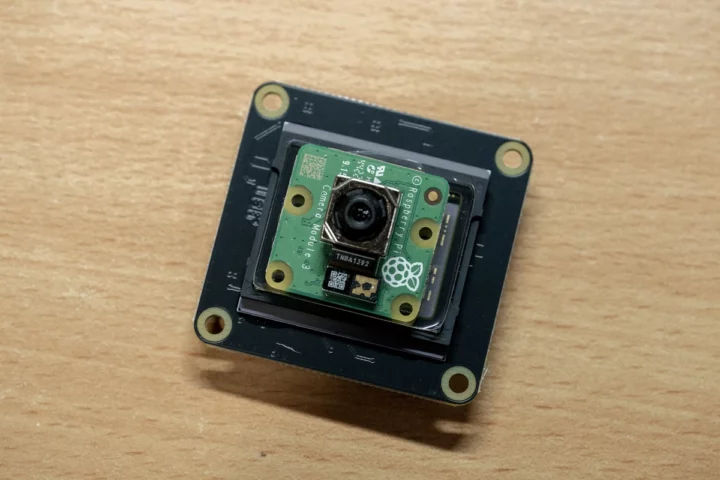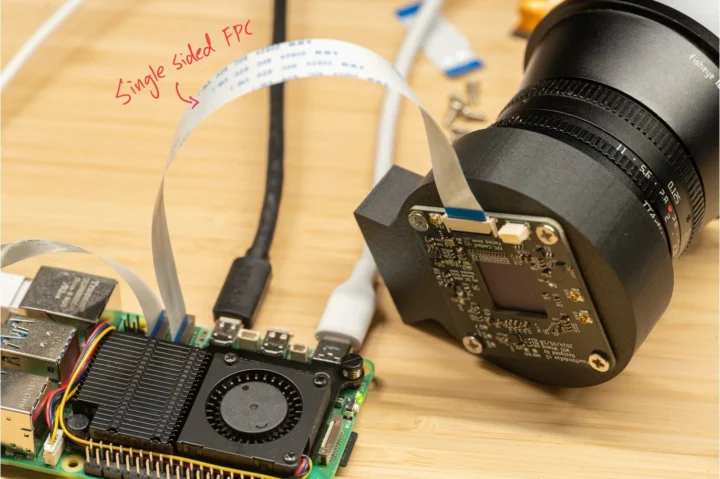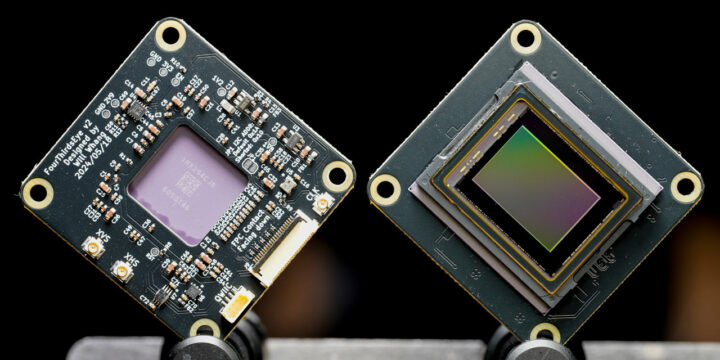Will Whang’s FourThirdsEye project is an open-source hardware camera module designed for Raspberry Pi 5 SBC and Raspberry Pi Compute Module 4 SoM using a Sony IMX294 Type 4/3 CMOS image sensor.
The camera module can capture 10.7 MP images and 4K (4096 x 2160) videos with improved low-light performance and dynamic range (4.63 μm pixel size) compared to existing Raspberry Pi camera modules. Will claims it’s perfect for photography enthusiasts, developers, and makers who want a more powerful camera for their Raspberry Pi projects.
FourThirdsEye camera module specifications:
- Sony IMX294 sensor
- Output image size – Diagonal 21.63 mm (Type 4/3) aspect ratio 17:9 & 4:3
- Number of effective pixels
- 4168 (H) × 2176 (V) approx. 8.93M pixels (aspect ratio 17:9)
- 3792 (H) × 2824 (V) approx. 10.71M pixels (aspect ratio 4:3)
- Unit cell size – 4.63 μm (H) × 4.63 μm (V)
- Optical blacks
- Horizontal – Front: 0 pixels, rear: 0 pixels
- Vertical – Front: 16 pixels, rear: 0 pixels
- Input drive frequency – 72 MHz (SLVS-EC) / 6 to 27 MHz (MIPI CSI-2)
- Output Interfaces
- SLVS-EC (2.304 Gbps / Lane) Max. 8-lane
- MIPI CSI-2 (1.728 Gbps / Lane) Max. 4-lane
- Supply voltage (VDD- 2.8 V / 1.8 V / 1.2 V
- Package – 248-pin LGA
- TMP117 temperature sensor
- Host interface – 4-lane MIPI CSI connector following the Raspberry Pi Compute Module 4 IO Board
- Compatible with Raspberry Pi 5 and Raspberry Pi Compute Module 4 boards with a 22-pin FPC connector

The module has been designed in Kicad 6, and all hardware design files, such as schematics, PCB layout, BoM, and Gerber files, can be found on GitHub under an MIT license. Will also developed an open-source IMX294 V4L2 Linux driver he made available in a separate repository. The CinePi project is recommended for capturing RAW videos on the Raspberry Pi. Instructions to get started can be found on the Wiki on GitHub.
While the IMX294’s CSI-2 interface is running at 1.78 Gbps, the Raspberry Pi 5 is limited to 1.5 Gbps and the Raspberry Pi CM4 to a slightly lower value (possibly 1 Gbps), but the FourThirdsEye module was successfully tested on both platforms. I suppose we won’t be able to shoot 4K 120 FPS videos as advertised on the IMX294 product brief, but 4K 60 FPS has been tested on the Raspberry Pi 5. The cable length and quality do impact data transmission, and a shorter 20cm cable is recommended as black/bad pixels may start to appear with longer cables.

Raspberry Pi has already released several camera modules, including the Raspberry Pi Camera Module 3 and the 12MP Raspberry Pi HQ camera, but the Sony IMX294 module used in the FourThirdsEye is of much higher quality. However, I did not find any photo samples that could showcase this higher quality.
You previously had to order the PCB and components yourself and do some soldering to get a FourThirdsEye camera, but it’s now much easier to get one, since it’s available on Tindie for $399. Sony IMX294 camera sensor appears to be hard to get, as it’s not listed on Mouser or Digikey, but I eventually found it on Aliexpress for $159.99. That price looked suspicious to me at first because USB 3.0-based IMX294 cameras sell for around $600, but based on comments I received below and on X, the sensor price is normal, and it can even be purchased for less (on Taobao).
[Update: The article was initially published on June 27, 2024, and updated following the launch on Tindie as reported by Hackster.io]

Jean-Luc started CNX Software in 2010 as a part-time endeavor, before quitting his job as a software engineering manager, and starting to write daily news, and reviews full time later in 2011.
Support CNX Software! Donate via cryptocurrencies, become a Patron on Patreon, or purchase goods on Amazon or Aliexpress





